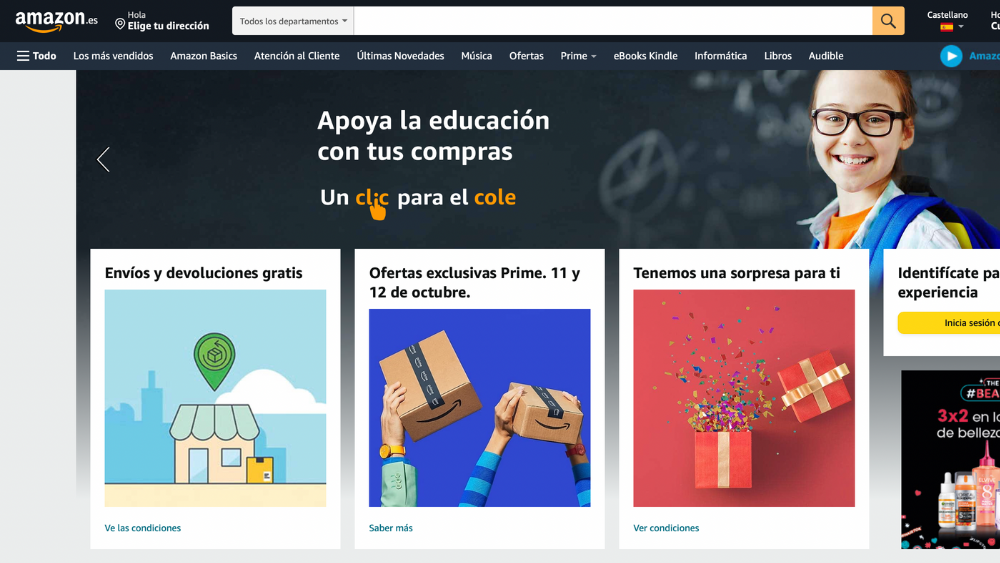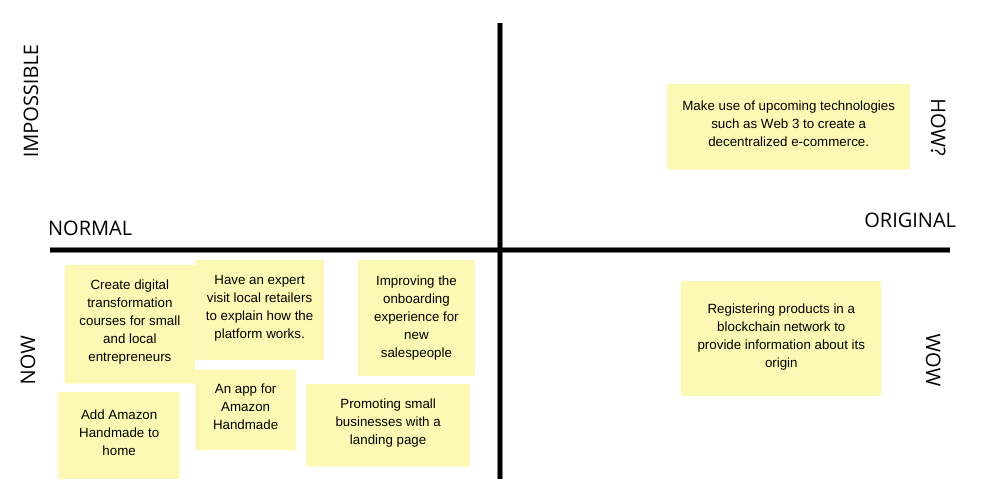2022
Developed a strategy to improve Amazon’s reputation and make a stronger bond with local businesses who are the most affected by the increase of online shopping.
ROLE
UX Researcher/ UX Strategist
TASKS
user research, data analysis, UX strategy
PROJECT DURATION
4 weeks
READ TIME
5 min

The process
01. Project overview
02. Research approach
03. Findings
04. Strategic UX
05. Final takeaways & next steps
1. Project overview
Evaluation of the project briefing and main objectives with exploratory research to identify problems and create a hypothesis.
1.1 Context
Amazon, as the world’s leading e-commerce platform, faces public perception challenges regarding sustainability and ethical practices. Despite their market leadership and diverse service offerings, they struggle with maintaining a positive image in these areas.
1.2 Problem statement
Amazon’s sustainability initiatives and local business support programs lack visibility and user trust, particularly in their Amazon Handmade platform and local commerce initiatives.
Business challenge
- Divided public opinion on sustainability practices vs. greenwashing
- Perception issues regarding worker rights and discrimination
- Concerns about product monopolization
- Low visibility of sustainable and local business initiatives
Goals
- Improve Amazon’s reputation through sustainable practices
- Adapt platform for sustainability-conscious users
- Better support local businesses and artisans
- Align platform services with sustainable and ethical values
2. Research approach
2.1 Methodology
DESK RESEARCH
To explore discussions in forums, social media, and industry reports on sustainable e-commerce trends.
SURVEYS AND SEMI-STRUCTURED INTERVIEWS
To gather insights on shopping behaviors and perceptions of Amazon’s sustainability efforts.
COMPETITIVE ANALYSIS
To compare Amazon Handmade with competitors like Etsy.
SEMI STRUCTURED INTERVIEWS
2.2 Target users
Current Amazon customers
(sustainability conscious and indifferent buyers)
Former Amazon customers (and switched to competitors)
Small business owners & independent sellers (potential Handmade sellers)
Environmental consciousness
According to a study conducted by Ipsos, Hotware Spain and Wallapop, “La Red del Cambio” (2021), Gen Z are the most environmentally conscious.
- 56% Z Gen
- 52% Baby Boomers
- 50% Gen X
- 48% Millennials
2.3 User personas


2.4 Research questions
- Why do users choose or leave Amazon?
- How is Amazon perceived regarding sustainability?
- What common problems do users face?
- Are users aware of and using Amazon Handmade?
- How do sellers perceive Amazon?
3. Key findings
- Users don’t trust Amazon’s sustainability efforts and believe they are just a marketing strategy.
- 56% of Gen Z and 52% of Baby Boomers are most conscious about environmental impact, but still shop on Amazon for convenience.
«Many companies invent certificates that say absolutely nothing.”
“I don’t think we can trust companies because they are always going to be looking for profitability.”
Convenience
Product variety
Lower prices
“There are simply no good alternatives. Funnily enough the market in recent years has begun to favor socially conscious companies, but no socially conscious company can have the broad reach fast turn around time, price of Amazon”
- Sustainability ranked lowest compared to price, shipping, and customer service.
“I always try not to buy from Amazon when the alternative is more or less easy.«
- 90% of surveyed users didn’t know Amazon Handmade exists.
- Handmade products are hidden in deep menus, making them difficult to find.
- Users associate sustainability with local businesses, but Amazon doesn’t highlight its small business sellers.

- High commissions & competition make it difficult for sellers to remain profitable.
- Many sellers struggle with visibility as Amazon prioritizes its own products.
- Onboarding & usability issues: Many small sellers lack digital expertise and find Amazon’s seller experience complex.
High commission rates
Digital knowledge gaps
Limited product visibility
Time-consuming product listing process
Minimal consumer interaction
Product counterfeiting issues
Competitive analysis
| Feature | Amazon Handmade | Etsy | eBay |
|---|---|---|---|
| Seller support | Limited | Moderate | Moderate |
| Visibility | Low | High | Moderate |
| Fees | High | Moderate | Low |
| User Trust | Low | High | Moderate |
4. UX strategy
Ideation Matrix (How-Now-Wow)
| HOW: Future innovation | Blockchain for product authenticity |
| NOW: Quick win | Improving Amazon Handmade visibility |
| WOW: High Impact, medium effort | Working on a seller onboarding app |

Kano analysis: what users expect vs. delightful features
| Feature | Expectation |
|---|---|
| Chat with customers | Basic expectation |
| Mobile-friendly product listing | Performance |
| Blockchain transparency | Exciter |
Customer journey map
Independent creative

Local business

5. UX solutions & impact
AMAZON IN OTHER COUNTRIES: INDIA
Amazon program to encourage local businesses to sell their products on the marketplace.
“Smart Commerce” program, helps to digitize small businesses that are totally unknown online.
What would I do differently now?
- If I had access to a different type of data from Amazon, I would have gotten data on how users arrive at the «Amazon Handmade» page. Explore the user journey and test its current effectiveness vs. the version with «Amazon Handmade» promoted on the home page. Would they be interested in it?
- Also, I would have loved to get access to the Amazon searches on «handmade» or in Spanish «hecho a mano», which in this case would be the most accurate one. That would be very useful to see the level of interest of Amazon users for that type of product and also to create categories within Amazon Handmade for a better experience.
- I would have interviewed small local commerces who sell their products on Amazon to better understand the pain points they experience during their user journey. In this case, I used the pain points signaled by the news article which was very helpful as well.

